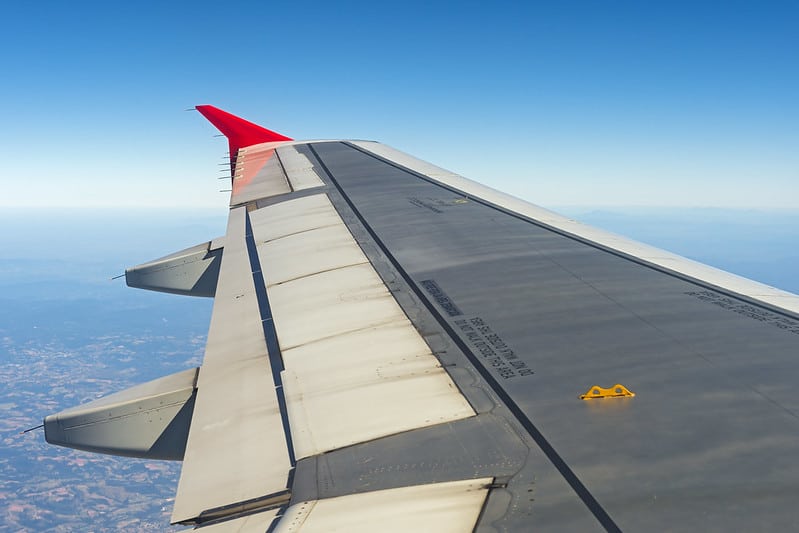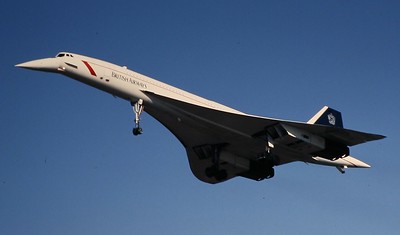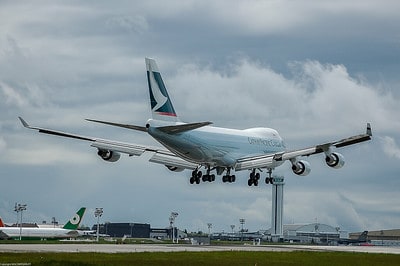
Whether you are a seasoned, new, or aspiring pilot, you likely have noticed that aircraft fuel tanks are commonly located in the wings instead of the main body or fuselage of aircraft. While high level consideration may attribute this to space concerns, there are actually some very intentional structural and safety considerations leading to this design.
Why are the fuel tanks located in aircraft wings?
Locating the fuel tanks in the aircraft’s wings improves the overall structural efficiency by counter-balancing the wing’s lift and the fuselage’s weight, reduces aircraft fuel system complexity, and improves passenger safety by locating fuel away from the passenger compartment.
The design concepts behind modern fuel tanks are interesting and do not require an engineering degree to understand. Three reasons for the placement of fuel tanks in the wing are described below.
Why are aircraft fuel tanks located in the wings?
The earliest aircraft designs featured fuel tanks installed in the fuselage of the aircraft, typically between the engine firewall and cockpit. This was a logical and reasonable location to install a fuel tank for a fabric covered aircraft that often had wooden wing structures. New aircraft designs typically locate the fuel tanks in the aircraft’s wings due to wing structure, systems, and passenger safety.
Wing Fuel Improves Structural Efficiency
Before considering an aircraft and its wings, first think about holding up a large brick. Holding the brick with one hand, slowly extend an arm, as you extend your arm the mass of the brick becomes increasingly difficult to hold. This is called a “bending moment.” Bending moments describe twisting stresses in a structure (pilots are familiar with the concept in weight and balance calculations which include weight, arm, and moment).
Bending moments drive much of the strength requirements for an aircraft’s structure. Now imagine if the brick is crumbled into tiny pieces and distributed along the length of your arm instead of at a single point in your hand. This is fundamentally the same principal as placing fuel in the wing.
Now to consider an aircraft and its wing. The mass of the aircraft is centralized at the center of gravity within the fuselage. That mass must be supported by the wings in flight. The more of the total mass located within the fuselage the more bending stress is applied to the wing root structures.
If some of that mass can be located away from the body of the aircraft, directly “beneath” the lift that is required to support that mass, the total wing bending moment is reduced.
Engineers refer to these forces as “upbending” (lift) and “downbending” (weight or mass). Fuel and engines are wonderful tools for introducing downbending along the wing to reduce wing root moments.
How do these bending moments affect the design of the wing structure?
Comparing an aircraft with wing fuel and an aircraft without wing fuel that weigh the same and produce the same lift, the aircraft with no wing fuel will require more cross-sectional area in its spar or spars. This results in a heavier wing structure or difficulty in creating a wing structure that conforms to the aerodynamic outlines of the wing.
Obviously then, by contrast, the wing fuel aircraft is able to use a lighter, thinner spar or spars to achieve the same resulting wing strength.
The ultimate expression of the use of downbending to increase bending strength of a wing is the “tip tank.” Tip tanks placed large quantities of fuel at the end of the wing, allowing the aircraft’s structure to bear higher weights than would otherwise be achievable.
Some tip tank STCs even allow for higher takeoff weights with fuel in the tip tank than with no fuel in the tip tank, and may even require fuel be burned from the main wing tanks until below a certain aircraft gross weight.
For a variety of reasons the FAA has ceased approval of tip tank installations, largely due to concerns with stability and control issues, but the potency of the technique is certainly measurable.
An interesting complication of loading fuel in the wing is that larger aircraft tend to include “Maximum Zero Fuel Weight” limitation.
For most aircraft the main landing gear are located in the wing structures, resulting in a non-zero bending moment at the wind root, even with an empty aircraft. If too much weight is added to the fuselage without fuel in the wing to balance the fuselage weight, the wing structure may become overloaded and fail prematurely, despite the aircraft weight being below the maximum takeoff weight.
Wing Fuel Simplifies Fuel System Design
Locating fuel in the aircraft wing substantially reduces fuel system complexity, particularly in high wing single engine aircraft. Considering the ubiquitous Cessna 172, fuel pressure is primarily supplied by the head pressure of locating the fuel above the engine. This head pressure allows for simultaneous feeding from both wings, eliminating the need to switch between tanks to maintain fuel balance.

In multi-engine aircraft, wing fuel allows aircraft designers to direct fuel from a wing directly to its respective engine.
In the King Air series aircraft, fuel drains under head pressure directly to the nacelle, minimizing the need for complex plumbing to balance fuel flow to each engine from a common tank.

Other multi-engine aircraft use similar system designs. Business aircraft require additional pumping to bring fuel to the engines, but the principal of feeding each engine from its respective tank is still used. In these systems it is common to allow feeding out of the opposite tank to allow for single engine operation, but this is considered an abnormal operating condition.
The alternative of feeding both engines from a single tank raises concerns for fuel contamination, flow balancing and pressure regulation.
Additionally, a fuselage tank would require complex and heavy baffling to avoid CG changes as a result of pitch changes and acceleration. Fuselage tanks would also impact the overall shape and size of the aircraft body, increasing the weight and drag of the aircraft unnecessarily.
A number of tactical fighter aircraft have used fuselage tanks as the primary fuel storage location, and pay substantial range penalties as a result in order to achieve the required performance. This type of range penalty has little application in the larger civilian aviation world where range and efficiency are more highly valued.
Wing Fuel Increases Passenger Safety
Beyond the engineering design benefits of wing tanks, a fundamental benefit to locating fuel in wing tanks is the improvement of passenger safety in the event of a leaking or otherwise compromised fuel tank. By locating fuel away from the passenger compartment, passengers are isolated from fires, leaks and other hazards for some additional period of time.
Particularly during ground fires, passengers are afforded valuable evacuation options when fuel is isolated from the fuselage.
Post-crash fires are a substantial contributor to passenger injuries and fatalities in aviation accidents, and as such, isolating passenger cabins from the initial effects of smoke and flames permits additional evacuation routes and time. It also allows fire rescue teams to treat the fire and the evacuation as concurrent, yet independent issues to be resolved.
There are safety benefits of wing tanks independent of failure cases as well. Wing tanks tend to centralize fuel around the center of gravity of the aircraft, reducing the impact of sloshing on pilot inputs and handling characteristics.
There are aircraft that use fuselage fuel tanks, but these designs are older and are being phased out of passenger and even cargo use. Two primary examples are the Boeing 747 and the Concorde. Both aircraft use fuel as a tool to maintain the desired center of gravity during flight.


The Concorde used forward and aft “Trim Tanks” to manage CG location as the center of pressure shifted forward and aft as the aircraft transitioned to supersonic flight.
Following the TWA 800 accident in the 1990s, the FAA dramatically increased the certification standards associated with fuselage fuel tanks, resulting in increased passenger safety, but at the cost of engineering complexity.
Conclusion
Aircraft designers consistently look for elegant solutions that reduce weight complexity and improve safety. Locating fuel in an aircraft’s wing became the preferred method for fuel storage as designers transitioned from wood and fabric structures to metal structures. Wing tanks improve the structural efficiency of a wing by “canceling” some of the bending moment from lift, reducing the size and weight of wing spars. Wing Fuel tanks also simply fuel supply systems by minimizing the complexity of fuel tank designs, and the associated pumps and plumbing. Finally, wing fuel tanks help isolate passengers from fire and fume hazards associated with jet and aviation fuel.
While you’re on the subject… here are other articles on Airplane Academy related to fuel:



